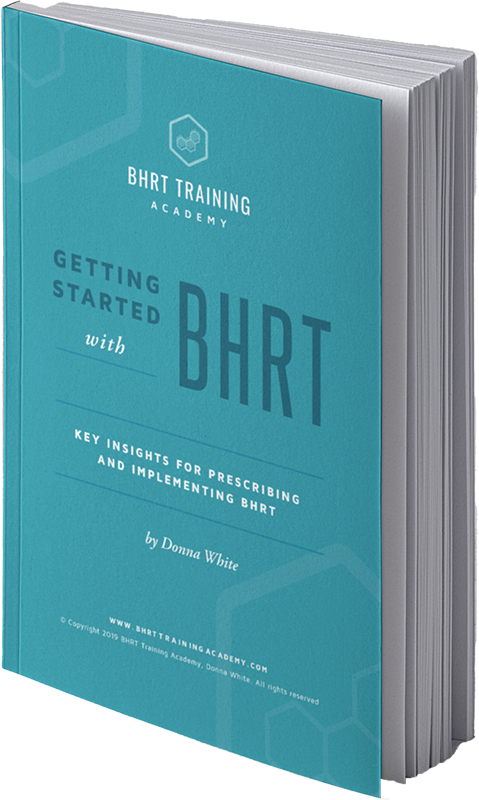BHRT Packaging and Prices with Toni Stroud

One of the most common questions that I hear in my training program is about the cost of BHRT.
Practitioners want to know how to package and price their offerings to ensure revenue and please patients.
I interviewed Toni Stroud, Provider Education Specialist with The BHRT Training Academy, to dig deeper into this topic. Toni was a healthcare consultant for 30 years, with the last 15 years focused on functional integrative medicine and BHRT.
How Demographics Affect the Cost of BHRT
The income level of a particular region will play a role in the overall cost of BHRT.
Donna: Are you saying that providers in smaller towns versus cities may not be able to charge as much?
Toni: Not necessarily.
I’m going to give you an example from Augusta, Georgia, to Aiken, South Carolina. They are less than 15 miles apart, and both of them are very small but very affluent towns.
So Augusta has a different demographic in its town, from Aiken, South Carolina. In their bioidentical hormone replacement therapy functional medical realm, their average payout for their programs is almost $1,000 difference.
So just because it’s a small town doesn’t necessarily mean anything; the demographics within that small town could be very affluent or very poor. But you have to look at all that.
When it comes to the cost of BHRT, you also have to look at other things like…if it’s a retirement community, and whatever products you’re using within your platform pertain to retirement age, then you have to consider whether or not they will benefit from that.
If they’re retiring, and that’s a fluent area, they usually can afford cash-pay services and not rely on just an insurance model. All that plays into account when you’re talking about a demographic that can support a cash pay model from age 35 to 75 or older.
In a retirement area, are people retiring there? Do the people have cash resources? Do they have expendable income?
Or is this a community, like a military community, which is often seen as just an insurance-based community simply because they are military, with good government benefits?
Even so, they may or may not rely on these benefits if expendable cash is available in the household. So even in a community with good insurance-based benefits, you have to look at the demographics as a whole.
Cash vs. Insurance
The cost of BHRT to the patient depends on how a practitioner structures their packages.
Donna: I understand that most practitioners who offer bioidenticals…are cash-based practices instead of insurance-based. Is that the case?
Toni: You have to ask yourself if you want to profit from the lab tests you order. If so, you can bring your lab services in-house and run all that under the umbrella of cash services.
If you are cash-based, then Insurance criteria for ordering lab tests won’t apply, and you won’t have to worry about the tests not being covered by insurance. Or you can outsource some of those blood tests.
If you practice in an insurance-driven demographic, it will be important to the patient that they use their insurance for lab tests.
There are many different tests that we can perform that are not even considered in traditional medicine. So it doesn’t matter that they had their labs done six months ago; we’re looking at things in a whole different manner.
Right now, there’s a practice in Charleston, South Carolina, that gives the patient the option of
- Having their lab tests done at the office, pay cash for the tests, and then they are run in-house or sent out if necessary.
- If the client has commercial insurance, they will outsource the tests to ..the insurance company.
They do not deal with Medicare or Medicaid because they don’t want to be obligated through contracts. So, if the client has commercial insurance, they are sent to the appropriate lab with a test order form to have their blood drawn, and the results will come back in a few days.
The patient has to file their insurance form with their insurance company to get reimbursed for the cost of the lab tests. The practice does not deal with the paperwork.
It is much easier to sell functional integrative services as a package versus ala carte because if you package services together, there’s no way to split them apart.
The Cost of BHRT: Pricing and Patient Perception
At first glance, the cost of BHRT may seem prohibitive to patients. Here’s what Toni has to say about getting beyond this.
Toni: The mentality of cash services is this. You must emphasize to the patient that when they first ask about the cost of your services, this is an investment in their health. Don’t just say… “here is the package price.”
Instead, use the term “investment.” It refocuses their thinking that they are doing this for their health and not focusing on the cost.
When they hear the word “package” the immediate response from the patient is to think of a discount. Typically it’s cheaper to put things together into a package than to sell services individually.
In restaurants, for instance, buying ala carte is always going to be more expensive compared to paying one price for a meal where you get a steak, a baked potato, and a salad together. It’s the same principle in package pricing.
Donna: The provider can also break down the annual cost into a monthly installment plan, right?
Toni: The most successful practices I work with give their patients the ability to pay by the month, quarterly, semi-annual, or annually all at one time. So by doing that, they’re offering packaged pricing.
You have to be very specific in your patient contract, so the patient knows exactly what they’re getting and understands what they’re not getting.
Providers need to decide: Are they going to treat their patients for thyroid disease when they discover there’s a major problem there? Or are they not?
If you don’t treat them, you’ve got to refer them out. Or the caveat to that is when they’ve been treated for thyroid issues by some other provider with unsatisfactory results.
Packages are so much better for the patient and the provider than ala carte services. So we are going to go with that as the foundation.
Donna: So I heard you say, yearly packages. Now I’ve seen some practitioners… offer an initial four-month practice package, and then they switch people to a maintenance care package.
Toni: Over the last 15 years, I have seen the annual package become the most successful model package, whether you’re doing pellets, pills, patches, creams, or whatever.
Typically, every quarter you are checking your patient and making appropriate adjustments. So if you model that around an annual service, you’ve got revenue for 12 months.
Using Contracts with BHRT Packages
Toni: There’s so much controversy about charging for the consultation.
Do we charge or not charge for the consultation? How much does the consultation cost? I have providers charging from $250 to $850 for the initial consultation.
This is a commitment that they’re making for their health. It’s also a financial commitment, and if they are on an annual contract, their credit cards will be set up to be drafted either once a month, once a quarter, semi-annually, or they can pay the annual service all upfront.
Emotionally, they have to be willing to commit to this. They’re committing not only to be compliant with the payment options but also to follow your expertise on treatment.
Compliance is an issue, payment is an issue, and you and I know the patient has to be committed to this.
The most successful business models advertise a “free consultation.” But here’s the caveat: The consultation is “free” only if they move forward with services because that charge, whatever it is, is applied to their pricing cost in the annual fee.
If they don’t move forward, they’re paying you for that consultation. It’s not free, because your time is not free.
Donna: What does that language look like when your front desk explains that to the patient, or is it on your website?
Toni: I would never have my front desk do that. I would always have someone on staff trained to discuss pricing while the patient is in the consultation room behind closed doors, discussing the pricing and payment options and getting a contract signed.
Hopefully, the money is taken while in that consult room, and the patient isn’t allowed the time to get from the consulting room to the front desk to check out. That’s my preference.
If, for example, the consultation is $250 and if you decide to move forward with us with further services, then the initial fee is applied to the cost of your annual service. However, if you decide not to go forward with further services, then you will be charged $250 at the time of your consultation.
Cost of BHRT: Fees and Ancillary Services
Toni: Your costs will depend on what your overall package fee looks like. The national average for a BHRT consult is $350. Some are priced lower, some way higher.
And then you have to decide who’s doing your BHRT consultation. Is it the medical personnel that’s also doing the treatments? Or are you, the provider? What does that person look like?
Do they meet the perimenopausal, menopausal, or post-menopausal criteria? You need to ask and find out where they are in this whole age range and what do they need? Why are they here to see you?
Also, consider what other ancillary services are already built into the practice model. Are you offering aesthetics? Do you have a weight loss program? So, all kinds of things play into this consultation.
How many visits or supplements or labs?
Then they look at what the cost is for those supplements. They will say to themselves, most of our patients are going to get, for example, these three supplements.
So we’re going to give an allowance of, let’s just say, $200 as a round number built into the contract. The contract should say you have a supplement allowance of “X dollars.” If we determine that you need additional supplements, there will be an additional charge.
Donna: What are practitioners charging for an annual package?
Toni: I would suggest that you not come in less than $2,500 a year regardless of your demographic.
Typically, by the time patients come to you for BHRT services, they have been to their family doctor, they’ve been to an endocrinologist, they’ve been to whomever, and they’re frustrated and even mad at times.
So they come to you because to them, you are it. You’re their last resource. At the consultation, you have convinced them by laying it all out how they’ve got every symptom in the book and qualify for your plan of treatment… So you’re giving them hope.
So they will find a way, just like if they want cable at home, or they need a new car, they’re going to find a way to pay for it. Now, here’s something fundamental. I have never seen in 15 years where a patient says, “ I have now optimized my hormones, and I’m never gonna do it again.”
If you’re interested in becoming a bioidentical hormone replacement therapy provider, drop me a line!
Enjoyed this article? Here are three more to help you:
How To Grow Your Integrative Medicine Practice
5 Reasons You Should Learn to Prescribe Bioidentical Hormones
Bioidentical Hormone Replacement Therapy: Frequently Asked Question

Get the quick read ebook,
Getting Started with BHRT -
Key Insights to Prescribing and Implementing BHRT.
CME's - Earn while you learn.
